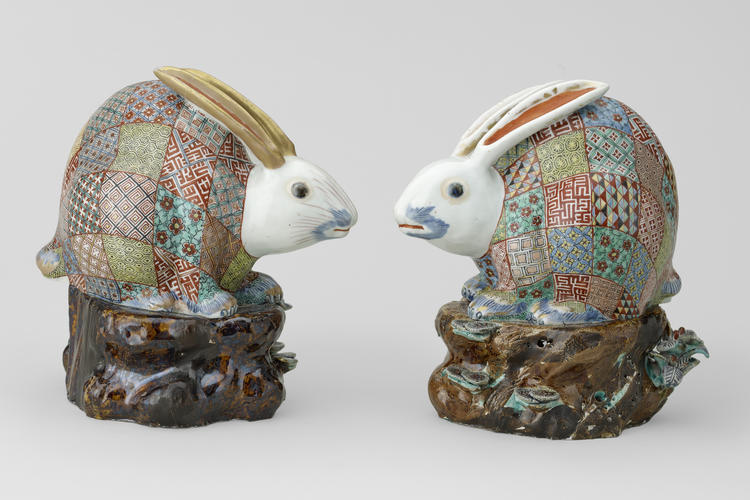-
1 of 253523 objects
Pair of pastille burners in the form of hares 1680 - 1720
Porcelain painted in underglaze blue, overglaze enamel colours and gold | 22.0 x 21.5 x 13.5 cm (whole object) | RCIN 100967

Japan
Master: Pair of pastille burners in the form of hares 1680 - 1720
-
Usagi (rabbits or hares) are often associated with the Year of the Rabbit, the fourth year in the jūnishi zodiac calendar. They appear frequently in netsuke and porcelain, as well as in screen paintings, prints and textiles. Mythology surrounding the hare was adopted from China, where the animal was associated with the moon and thought to assist in preparing the elixir of immortality. The theme of longevity is reinforced here by the reishi (fungi) growing on the rocks; these fungi are said to proliferate on Mount Hōrai, the mystical land of the Immortals.
The colourful geometric and floral designs give these hares a playful, humorous feel. These patterns were charmingly described as ‘harlequin patches’ when the pair was inventoried at the Royal Pavilion, Brighton in 1829. The decorative pieces serve as pastille burners, and the incense when burnt diffuses through holes in the brown glazed rockwork.
The hares evidently appealed to successive generations of royals. Originally acquired by George IV for Brighton on 5 April 1818, the pieces were later sent to Buckingham Palace, where by 1911 Queen Mary displayed them prominently on top of a Chinese cabinet in the ‘Lacque Room’ [sic] in her private apartments. Queen Elizabeth The Queen Mother (1900 –2002) subsequently used them to furnish her rooms at Clarence House. There, they formed part of a menagerie of Chinese and Japanese porcelain animals which surely appealed to her discriminating taste and sense of humour.
Crouching hare burners on a rockwork base, open above and below, with feet and tail projecting, the long ears resting on the rounded back; the head white with blue whiskers, the eyes ringed with gold, the ears red and gold, the feet with gilt claws. The body is draped with a multi-coloured patchwork coat of varied diaper patterns, splashed with light and dark brown glazes; the base has green fungi growing on ledges, and holes pierced to emit incense from an inserted burner, the underside having strut supports and modeller’s fingermarks.
Text adapted from Chinese and Japanese Works of Art in the Collection of Her Majesty The Queen: Volume II and Japan: Courts and Culture (2020)Provenance
Acquired by George IV, 1818. They were bought from Robert Fogg ‘2 Japan China Rabbits for Brighton’, 5 April 1818 (National Archives LC 11/25). Sent to Buckingham Palace in March 1847: ‘A pair of china rabbits enamelled in harlequin patches’ (1829A, p. 20).
Recorded in the Lacquer Room at Buckingham Palace in 1911 (BP 1911 IV p.199). -
Creator(s)
(nationality)Acquirer(s)
-
Medium and techniques
Porcelain painted in underglaze blue, overglaze enamel colours and gold
Measurements
22.0 x 21.5 x 13.5 cm (whole object)
21.9 x 21.0 x 13.5 cm (whole object)
Other number(s)
Place of Production
Arita [Saga]